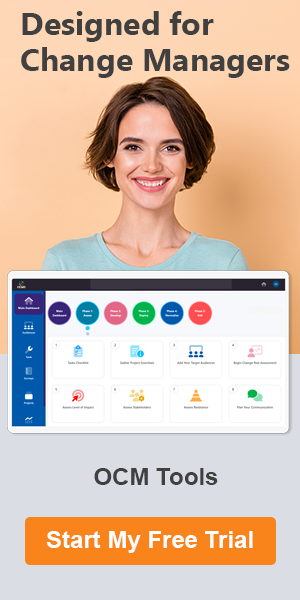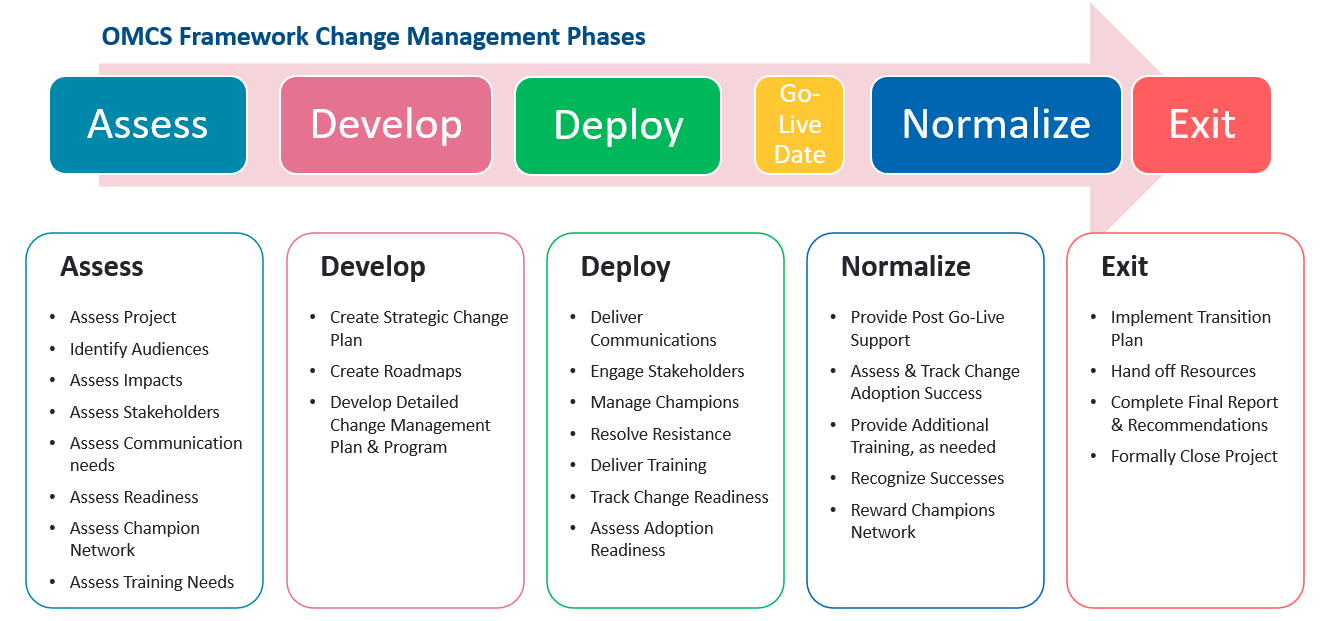Change Management Office Structure & Setup
 Embarking on a journey of organizational change can be as exciting as it is challenging. In a world where businesses are constantly evolving, having a well-structured Change Management Office (CMO) can be your secret weapon to navigate these shifts successfully.
Embarking on a journey of organizational change can be as exciting as it is challenging. In a world where businesses are constantly evolving, having a well-structured Change Management Office (CMO) can be your secret weapon to navigate these shifts successfully.
A CMO is oftentimes also referred to as Change Management Center of Excellence (CoE), Change Management Practice (CMP), Transition Change Management (TCM), and Change Management Team.
Whether you’re adapting to new technologies, restructuring departments, or refining company culture, setting up CMO functions can make all the difference between success and failure.
In this article, we’ll embark on an exploration into the art and science of establishing a CoE/CMO/CMP/TCM. From crafting a mission statement that resonates with your team to leveraging the latest tools, we’ll uncover the essential steps, tips, and tricks to ensure your change initiatives not only thrive but also create a positive ripple effect across your entire organization.
First up is a quick summary you can enjoy if you’re short on time. If you’d like more detail, keep on reading for a deeper dive into change management roles and responsibilities and setting up a CMO change management office.
Quick Summary
What Is a CoE or CMO Organization?
A Change Management Center of Excellence (CoE), also called a Change Management Office (CMO), is an internal group within an organization that offers change management services and support to stakeholders and project teams through a “Change Management as a Service” approach.
The change management excellence center or CMO organization has its own mandate, strategies, practices, and policies. Establishing and managing a Change Management Office (CMO) is crucial for effective change management.
Organizations can refer to their CoE as a Change Management Practice, OCM Function, CMO Organisation, Change Team, Change Management Community of Excellence (CoE), or something similar. When setting up the practice, a change management charter outlines the services, plans, and change management roles and responsibilities.
CMO Project Management Service Plans
When developing change management functions for a CMO Change Management Office, organizations should consider different service plans, which should be outlined in the change management charter.
Types of CMO Organization Service Plans are:
- Full Change Management CoE Service:
- Provides 100% change management support for high-profile, transformational, high-risk, enterprise-wide projects.
- Assigns a dedicated change practitioner responsible for all aspects of change management.
- Partial Change Management CoE Service:
- Offers part-time change management support for small-to-mid-sized projects.
- Assigns a change practitioner from the CoE in an advisory role, supporting the project team.
- Self-Service Change Management Support:
- Provides change templates, tools, and guides to stakeholders for small projects.
- CoE does not directly engage in the project, only provides self-service change management tools.
Organizations adopting these services need to educate project teams on utilizing self-service tools. Change management roles and responsibilities can get blurred without clear communication of the change management team structure and CMO functions.
OCMS Portal software offers comprehensive change management tools, catering to all aspects of CMO functions from initiation to completion.
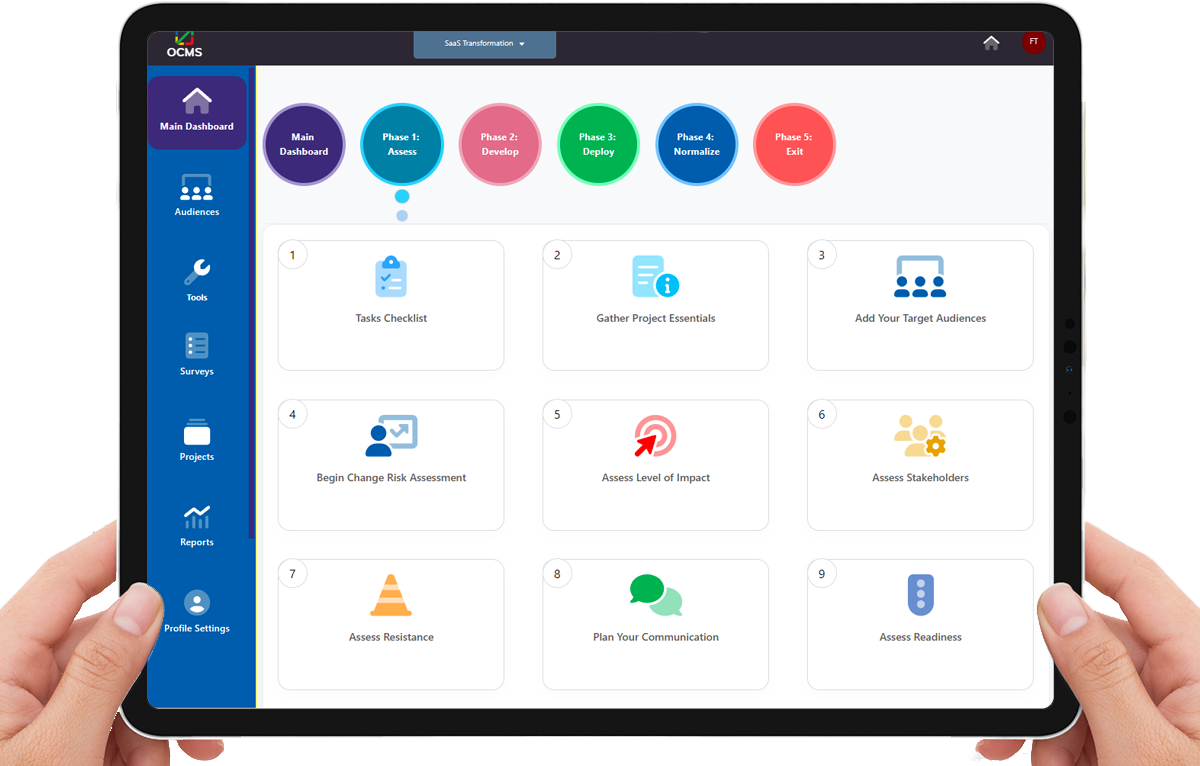
CMO Functions: Change Management Charter
Creating a Change Management Charter is crucial when launching your change management team structure. It serves as a formal document outlining the office’s understanding, objectives, roles, and responsibilities.
This charter establishes a unified approach across the Change Management Office structure, ensuring consistency in strategies and processes across projects. It provides accountability, fosters a shared vision for success, and enhances communication among team members and external stakeholders.
By defining the team’s purpose, processes, and change management capabilities, the charter not only internally benefits the Change Management CoE but also conveys the office’s value and operational methods to the entire organization. It promotes a comprehensive understanding of its functions and contributions.
Charter Details for Change Management Excellence
When establishing a CoE or CMO functions, crafting a comprehensive Change Management Charter is paramount. This document serves as the cornerstone, guiding the CMO’s purpose, change management team structure, and operations.
Within the charter, several key sections are pivotal, each contributing to the office’s effectiveness and seamless functioning. These components provide a structured framework for the CMO’s activities and change management capabilities and underpin the success of any change management initiative.
Change Management Charter Details & Sections:
- Mission and Objectives:
- Clearly state the purpose and objectives of the CoE or CMO and its larger mandate within the organization.
- Offerings:
- Outline the types of services provided to project teams and stakeholders.
- Team Members & Structure:
- Define the change management roles and responsibilities of team members, including Change Agents, Change Champions, Leadership & Sponsors, and potentially Change Ambassadors.
- Roles and Responsibilities Per Offering:
- Specify the level of CoE change management capabilities based on the type of service provided to a project.
- Change Framework:
- Explain the change management delivery framework used for projects, detailing the phases and tasks involved.
- Communication Process:
- Document internal and external communication methods, emphasizing regular team meetings and varied stakeholder communication strategies.
- Success Assessment:
- Define key performance indicators (KPIs) and metrics for measuring success, aligning with the team’s mission statement.
- Rules for Resolving Conflicts:
- Establish ground rules for handling disagreements, emphasizing constructive feedback, respect, active listening, and collaboration.
Best OCM Tools & Templates for Your Change Management Office
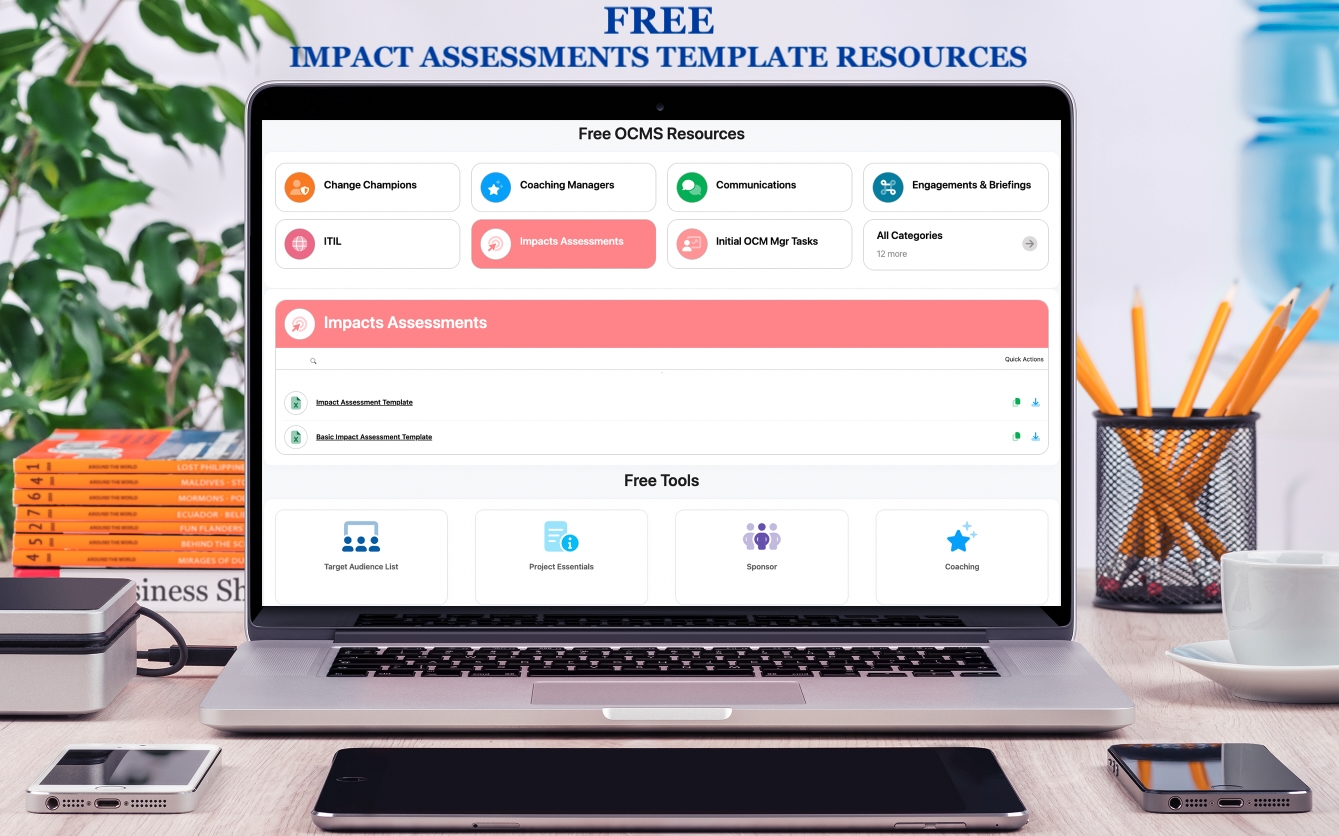
Whether you need tools for full-service or self-service change management functions, OCMS Portal has everything you need! We have an extensive assortment of free templates, paid software tools, change management surveys, assessments, smart reporting, autogenerated engagement plans, and more!
Check it out now by signing up for a free trial. (no credit card needed)
Launching and Managing the CMO Organization
To successfully launch and manage the CMO or CoE, it’s essential to finalize and obtain signoff on the charter, ensuring alignment with organizational goals. Additionally, educate stakeholders and project teams about the CoE’s value and services through walkthrough briefing sessions.
Provide continuous support to those in your change management team structure, ensuring they adhere to best practices, and commence offering change management services using the charter’s guidelines. Maintain open communication channels with stakeholders, ensuring ongoing collaboration and addressing evolving project needs.
Summary Conclusion: CoE / CMO Setup & Management
By investing in a robust change management team structure, you’re not just mitigating risks; you’re nurturing a culture of adaptability and resilience within your organization. Every obstacle becomes a chance to refine strategies, and every success is a testament to the dedication of your team.
In the evolving landscape of business, change is inevitable. But armed with the knowledge, tools, and insights shared here, you have the power to transform uncertainty into knowledge and confidence. Your Change Management Office isn’t just an office; it’s a beacon of stability and innovation, guiding your organization toward endless possibilities.
Detailed Deep Dive
How to Plan, Launch, and Manage the Best Change Management Center of Excellence (CoE)
This guide provides you with everything you need, including a step-by-step overview for planning, launching and managing the best Change Management Office for your organization. A Change Management Center of Excellence is also referred to as a Change Management Community of Excellence (CoE), Change Management Practice (CMP) and a Change Management Office (CMO).
You can establish your Change Management Practice as an internal consultancy that provides change management services to groups and stakeholders across your organization or you can manage it as its own department. Your CoE can have multiple offerings: full change management services, partial change services, and self-services. We will explain all of these offerings below.
A decade after Steve Jobs handed the reins of leadership at Apple to Timothy Cook, I was hired as an Organizational Change Consultant to establish Apple’s Business-to-Business (B2B) Sales Organization Change Management COE. I created this change management center of excellence (CoE) from scratch, and I am sharing the steps and best practices in this article for change managers, project teams, and program leads to leverage and use for their needs.
After reading this guide, if you still need help in planning, designing, establishing, launching, and managing a Change Management Center of Excellence (CoE), click here: 1-on-1 Change Management Coaching, Support & Help for Change Managers.
Ogbe A.
Sr. Change Management Lead & Coach
Strategic & Tactical Change Management
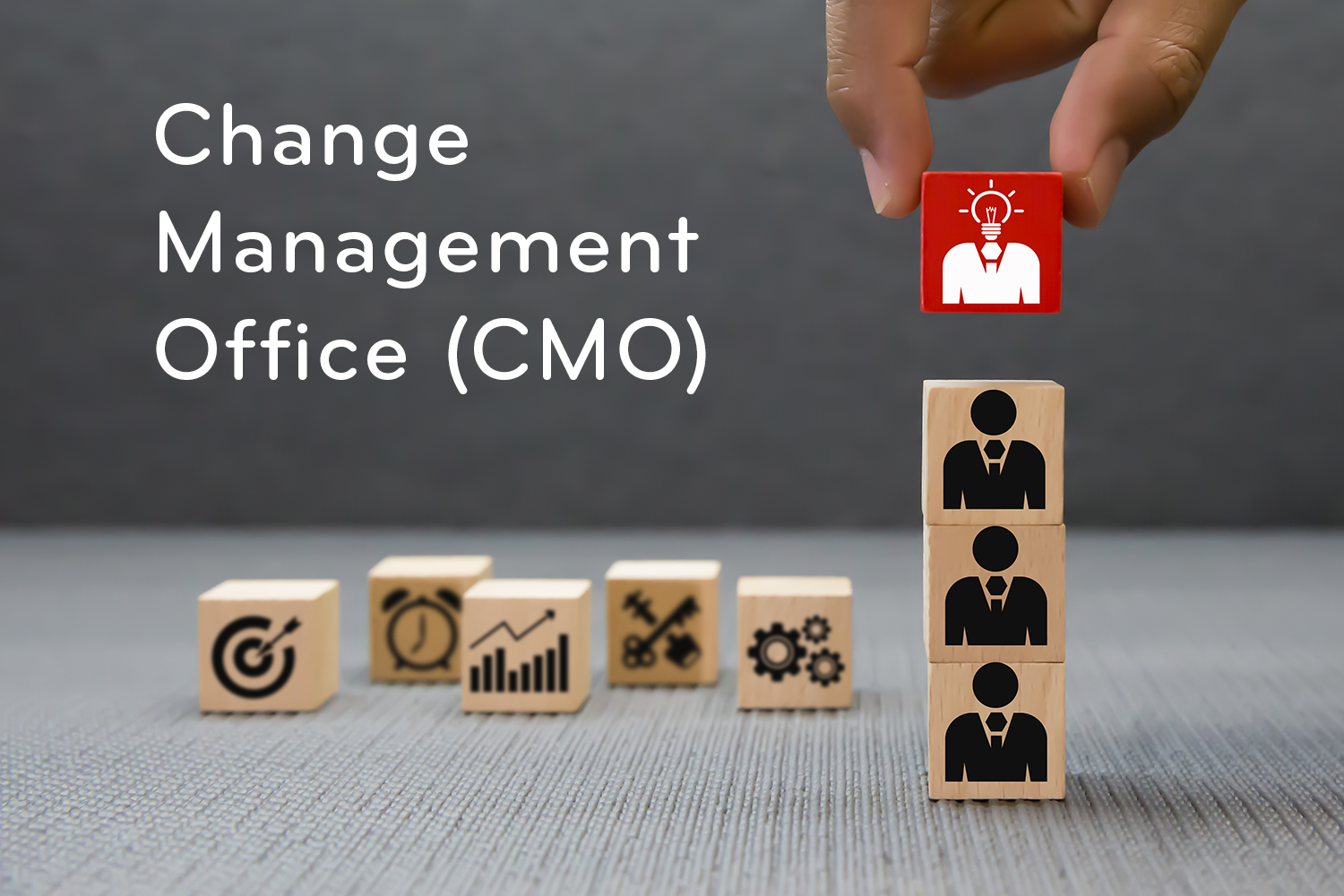
Contact us if you have any feedback or questions about this change management CoE guide or any of our helpful change management guides.
Contents: Establishing, Managing & Expanding a Best Change Management Department
- What Is a Change Management CoE, Office, Practice, & Function?
- What Should You Call Your Change Management Function?
- What Services Should Your Change Management Practice Offer?
- Creating Your Change Management Charter
- Change Management Charter Details & Sections
- Creating the Change Templates and Tools
- Launching, Managing, & Expanding the Change Management Practice
Contact the OCM Solution team if you have any feedback or questions about managing a change management center of excellence CoE.
In addition, if you are very experienced in change management but would like to bounce ideas off another experienced change management lead, or if you are a new change management practitioner and are looking to learn best change management practices, you can reach out to us for change management coaching.
What Is a Change Management CoE, Office, Practice, & Function?
A Change Management CoE is an internal group that provides change management services and supports to stakeholders and project teams across an organization in the form of a “Change Management as a Service” approach. A Change Management Practice COE has its own mandate, strategies, practices, and policies.
Planning, establishing, managing, and expanding a Change Management Office for your organization is a vital part of any effective change management program. Groups, teams, and stakeholders would reach out to the Change Management Center of Excellence (CoE) for change management help, and the Change CoE team or lead would review each request to determine which service was best suited to that particular change program.
As part of establishing the CMO project management practice, you will need to draft up a change management charter (described in the sections below), which will include the services and plans being offered by the change practice, as well as the change management roles and responsibilities that will be delivered based on each plan offered.
What Should You Call Your Change Management Function?
A Change Management CoE is generally referred to as one of the following:
- Change Management Practice
- Change Management Function
- Change Management Center of Excellence (CoE)
- Change Management Office (CMO)
- Change Team
- CMO Organization
- CMO Organisation
- Change Management Community of Excellence (CoE)
- Change Management Department
You can use any of the above names for your CoE. For example, you can call your practice: <Insert Name of Your Organization> Change Management Practice. E.g.: Microsoft Supply Chain Change Management Practice.
What Services Should Your Change Management Practice Offer?
See below for the various services and plans generally offered by a Change Management Practice.
When developing your change management charter, you will want to include these offerings as part of your charter as well as clearly stating the change management roles and responsibilities and tasks that will be provided per each service plan as part of your Change Management Office structure.
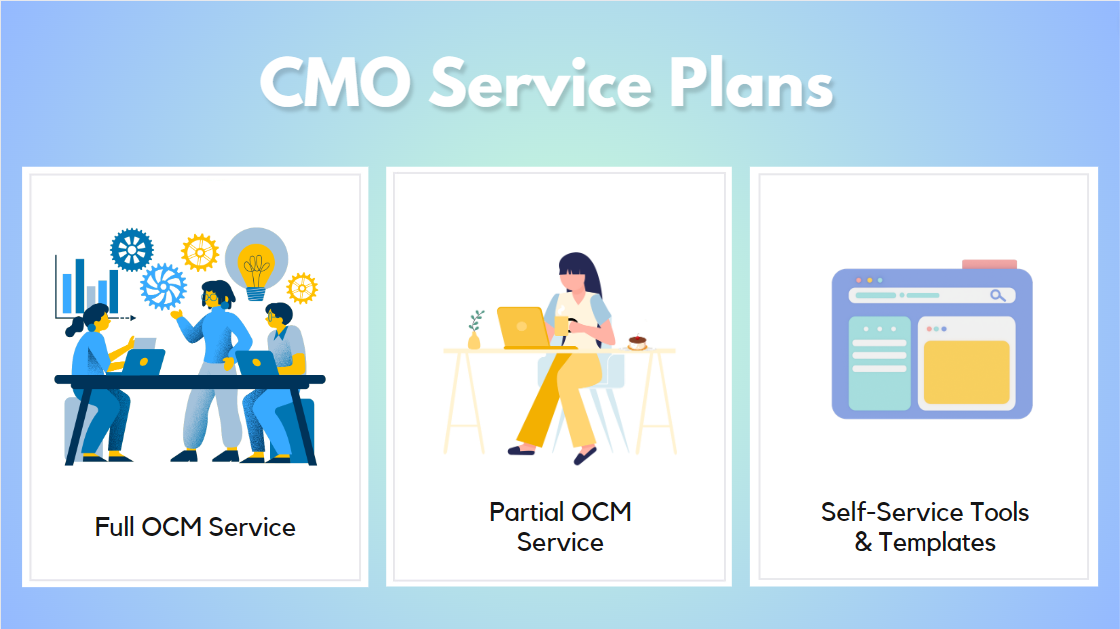
1. Full Change Management CoE Service
A full-service plan involves providing 100% change management support and services to a project.
The Change Management Office assigns a change practitioner from the CoE to the project, and that practitioner is fully responsible for delivering all aspects of change management including change assessments, creating and delivering the change plans, and helping to reinforce the change after go-live.
Offering a full-service change management function plan to a project is generally best when the project is high-profile, transformational in nature, high-risk/high visibility, enterprise-wide impacting, or impacting a wide/important group or groups.
In the event that the change management department does not have enough resources or bandwidth, then a Partial CoE Service might be best even if the project is high-profile, transformational in nature, high-risk/high visibility, enterprise-wide impacting, or impacting a wide/important group or groups.
2. Partial Change Management CoE Service
A partial service plan involves providing part-time change management support and services to a project.
In this case, the change management department will not be responsible for delivering 100% of the change management tasks for that project, but instead will assign a change practitioner from the change CoE to coach and support the project team or leads.
The change practitioner from the Change Management Office will not be responsible for delivering 100% of the change management tasks for the project, instead the change practitioner from the CoE will play an advisory role, and also help deliver some of the change deliverables.
A partial service plan is generally best when the project is a small-to-mid-sized project that is not transformational in nature, and is not impacting a wide range of groups.
3. Self-Service Change Management Support
With a self-service approach, the Change Management CoE will provide change templates, tools, and guides (or a suite of change management toolkits) to the stakeholders/project teams for a particular project.
The Change Management Office will not be involved in the project and will not be conducting any change management functions or activities. Instead, it will only be providing change management tools.
A self-service plan is generally best when it’s a small project, or when the CoE does not have enough bandwidth or resources to support the project.
You will need to educate the project team and stakeholders on how to use the self-service tools and guides. At a minimum, you should provide at least one 45-60 minutes briefing session where you or members of the Change Management Practice will walk the stakeholders through the self-service change management toolkits and educate them on how to use these tools.
Reach out to us if you have any feedback or questions about launching and managing the best organizational change management offices or CMO functions.
OCMS Portal – A Full Suite of Change Management Tools & Templates
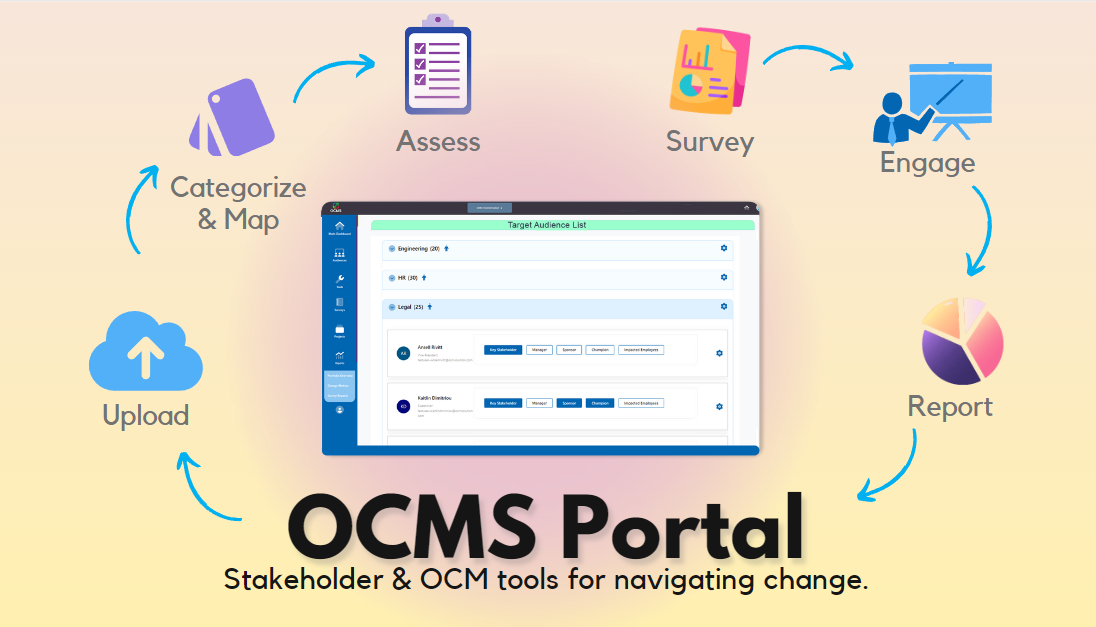
OCMS Portal has a full suite of collaborative change management tools that makes it easy for a CMO Organization to provide all levels of service. Try them for free now by signing up for a no-risk trial.
Creating Your Change Management Charter
When launching your Change Management Office, you will need to create a charter. A change management practice charter is a formal documentation that outlines the understanding, scope, objectives, and function of the change management office, and will also define the roles and responsibilities of each party involved.
A charter outlines what your team stands for and how they will operate. By creating a document of shared goals, strategies, and processes, your change management team can start every project on a united front, using a consistent approach and methodology.
A change management office charter is important as it:
- Provides accountability for the members of the Change Management CoE
- Delivers a consistent CoE approach
- Outlines a customized team process document
- Establishes a shared vision for project success and support
- Defines change management roles and responsibilities
- Improves communication among members of the change practice and external stakeholders
- Ensures all team members understand the ideals and vision of the change office
In addition to their internal change management office benefits, your charter will also show your team’s purpose to the rest of your organization.
Not only will your team be explicitly stating your purpose, value and process in the charter document, but as other stakeholders across your organization review your charter in its entirety, they’ll gain a full understanding of how the Change Management Office will operate, and the value it provides.
Change Management Charter Details & Sections
The charter for a Change Management Office should include the following sections:
- Mission and Objectives
- Offerings
- Team Members
- Roles & Responsibilities Per Offering
- Communication Process
- Success Assessment
- Rules for Resolving Conflicts
- Socialize and Sign-Off the Charter
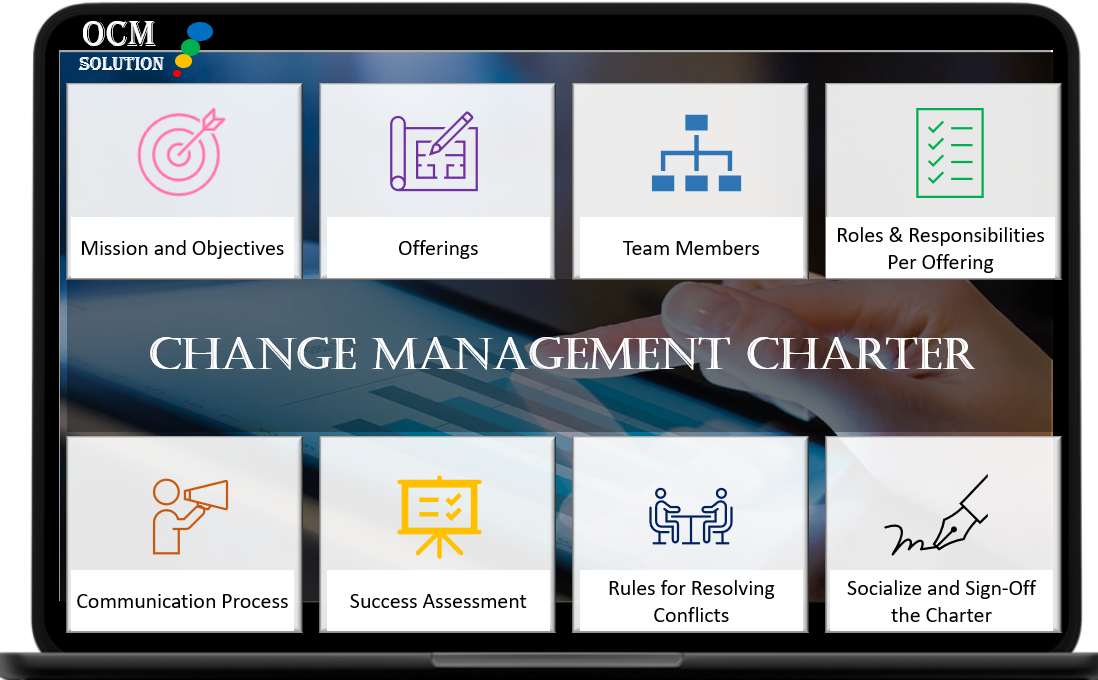
Mission and Objectives
On the charter’s mission and objectives slide or page, state the purpose of your team and what you collectively seek to accomplish. What is the purpose of the Change Management Practice? What are your mandates?
While the Change Management Office (CMO) will support multiple projects, there’s a larger mandate that describes the function of the CMO. Consider this larger mandate when drafting your change management team’s charter: How will the change practice work with stakeholders within the company? What is the overall purpose of the change practice? Thinking through these questions will help you state your team’s purpose.
For example:
The purpose of the <Name of Your Organization> Change Management Office is to provide change management services, support, and delivery using a “Change Management as a Service” approach.
We will engage and consult with project teams, project sponsors, leadership team, and other stakeholders to deliver change management deliverables that will enable impacted users to adopt organizational changes and business initiatives.
The Change Management Practice will apply a suite of change management tools, services, and guides to increase end-user change adoption and proficiencies. The change practice will help increase overall return on investments (ROIs) for in-flight and future projects, programs, and business initiatives.
Tip: Use a creative approach to come up with your team’s purpose. Engaging with members of the team to state your purpose can be a bonding opportunity. Ask team members to brainstorm the Change Management Function’s purpose and write down all of their ideas. Then, try narrowing the list down to one or two paragraphs. This will then become the formal mission statement for the Change Management Office.
Offerings
Your change management charter should include an Offerings section that outlines the different types of offerings your organization will provide to project teams and stakeholders.
Visit this section above for more details: Change Management CoE Offerings (Services and Plans)
Team Members & Structure
Your charter should include an overview of the team members and overall structure.
Create an org structure for the change management practice. Starting with the highest-ranking member of the group, break down your team structure per job role. Also, you should include a sentence or two about the responsibilities associated with each role.
The members of the change practice will include:
- Change Agents. These are Change Management Practitioners whose day-to-day job involves drafting, delivering, and managing change management. Every day they live and breathe change management.
- Change Champions. These are individuals whose day-to-day job is not change management. Instead, they are being solicited to support change programs that are impacting their groups. These individuals might be Sales Managers, Engineers, Admins, Operations, Legal Specialists, Licensing, Manufacturing, etc. who have their normal business job role that is not change management.
- Leadership & Sponsors. These are individuals at the leadership level who are advocating for the change management practice.
The members of the change practice can also include:
- Change Ambassadors. These are change management professionals that support the Change Agents as they deliver hands-on change management throughout the departments. Ambassadors coach Change Agents and may also provide program-level change management reporting across all projects to executives.
The Team Members section in your charter will be really helpful as it allows others to understand the role each member of the CoE performs. Most importantly, it helps reinforce to team members what his or her role is, as well as expectations. At the same time, it also serves as a reference guide that will help each member of the CoE to understand what their coworkers are working on.
Tip: Use a creative approach when defining your team’s structure and change management roles and responsibilities. Engaging with members of the team to state the change roles and responsibilities can be a team building and bonding opportunity. Meet together – either via an in-person meeting or virtually in a video call -and challenge members of the team (including change champions, agents and others) to learn about each other, and each other’s responsibilities.
Roles and Responsibilities Per Offering
In this section, state the level of change management roles and responsibilities that the CMO team members will provide based on the type of service being provided to a project.
See more information here: Change Management CoE Offerings (Services and Plans)
Change Framework
Explain the change management delivery framework that will be used for the different types of projects. A change delivery workflow is an end-to-end, repeatable flow that outlines the various phases and tasks that will be delivered.
You can review and leverage our Change Management Framework, which is a 5-phase change model that uses a proven, real, “change management deliverables approach” for practical hands-on implementation of change management versus the theoretical change management scenarios used by a lot of change management methodologies.
Communication Process
Establish and document the various ways in which the change practice will communicate internally as a team as well as externally to stakeholders, and project teams. There is no one-size-fits-all. For communicating with some stakeholders, a standard weekly or bi-weekly report via email might suffice. For other stakeholders, having meetings on a weekly, every other week, or once a month basis might be required.
Internally, amongst members of the CoE, regular virtual or face-to-face meetings is recommended for communications and brainstorming.
Success Assessment
Part of establishing a change management practice includes defining what success will look like. How will you track whether your activities are successful? Your overall success KPI will be connected to your mission statement. How well is the team reaching that mission statement?
For project-based success tracking, you will want to track awareness, impacted user engagement and buy-in to the project, knowledge and change reinforcement. Read more here: Change Management KPIs and User Adoption Metrics for Change Managers & Project Management Leads.
Your team should have a general way to measure what the various success metrics and KPIs will look like. Generally, it is recommended that you apply a mix of your CoE’s objectives, as well as subjective ways to define the various levels of successes. Applying such a mix will ensure that your team and the overall practice does not fall into a routine of supporting projects without considering all perspectives first, including the exit criteria.
Rules for Resolving Conflicts
Members of the change practice team will inevitably disagree. While such levels of conflicts aren’t a bad thing, it is essential that you establish a basic set of ground rules to prevent disagreements from escalating.
Examples of such ground rules can include:
- Team members should only provide feedback or criticism in a constructive manner
- Team members should always treat others with respect, and practice active listening
- Team members should always assume positive intent, and discuss conflicts openly
- Treat customers, coworkers, and managers equally
- Celebrate each other’s accomplishments, and find solutions together
With such a simple list of conflict resolution guidelines, the group can minimize conflicts and miscommunication.
Tip: Turn this section of the change management charter into a collaborative and team building event. Gather members of the team together and act out challenging situations. Practice using the ground rules to find common ground.
Socialize and Sign-Off the Charter
After drafting and integrating feedback into the charter, the next step is to review it with key leadership stakeholders and sponsors to get their sign-off and blessing.
Everyone who is connected with the change management office including at the leadership level should be in alignment regarding the contents included in the team charter. To maintain ongoing alignment, you should review the charter (and update it as needed) and re-share the charter with members of the team on a quarterly basis. In addition, on a regular basis, you can hold a 30-minute meeting and invite all team members to discuss, review, edit and make improvements to the charter.
Creating the Change Templates & Tools for the CoE
It’s important to have a consistent set of change management templates and tools for the team members of your Change CoE to use. These should include the ability to generate analytics reporting on change progress and give team members one place to manage all change management activities. Using a centralized change template, software, or tool, also allows for program-level reporting across all projects in the organization.
In developing your full suite of change management toolkits, you will want to consider developing the following:
- Change Impact Assessment Tool
- Change Management Communications Planning & Management Tool
- Change Management Project Risk & Success Assessment Tool
- Change Metrics & KPI Tracking Tool
- Coaching Leaders & Employees Through Change Tool
- Organizational Readiness Assessment Tool
- Resistance-to-Change Assessment & Management Tool
- Stakeholder Assessment, Mapping, Engagement & Management Tool
- Tool for Managing Change Champions & Agents
- Tool to Manage Training Programs for Employees & Managers
You can also leverage OCMS Portal’s All-in-One Change Management Solution for your needs.

Enjoy a streamlined user experience, tools that walk you through all change management functions, and autogenerated OCM and stakeholder engagements plans. (And that’s just the tip of the iceberg!)
Start your free trial today (no credit card needed).
Launching and Managing the Change Management Practice
- Finalize and get signoff on the charter
- Finalize the change templates, strategies, and toolkits
- Provide communications to stakeholders and project teams
- Conduct walkthrough briefing sessions to educate stakeholders, groups, and project teams on the Change CoE’s value, service plans, and etc.
- Educate change champions and support stakeholders on best change management practices
- Start taking on projects and offering change management services using the team’s charter to guide which project to take on and what services will be offered.
- Provide ongoing communications and meetings with the appropriate stakeholders
After reading this guide, if you still need help in planning, designing, establishing, launching, and managing a Change Management Center of Excellence (CoE), click here: 1-on-1 Change Management Coaching, Support & Help for Change Managers.
Image credit: stock.adobe.com





